Polar Bears weigh around 150-680 kilograms and have an average length of 1.8-3 meters. A male polar bear is 2.4-3m (8-10 feet) long from nose to tip of tail. The length of a female polar bear is 6 to 8 feet. Male polar bears are 3 times bigger than female polar bears.
Polar Bears have different sizes. Their size is dependent on many factors: age, location, and food availability. They are all, however, so large that they are recognized as the biggest and tallest bears among the other bear species. They always stand out from the crowd due to their size.
How Big Is a Full-Grown Polar Bear?
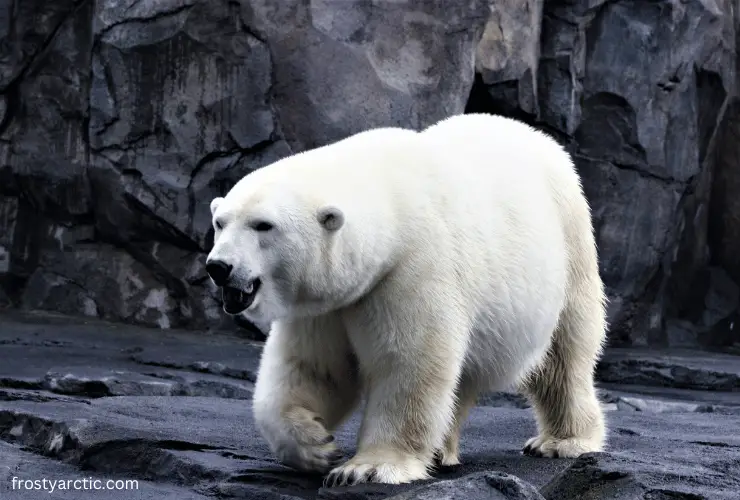
As one of the largest land carnivores on Earth, the polar bear stands as a sign of resilience and adaptability against icy challenges. Just picture this: an adult male polar bear is standing bravely with over 600 kg of weight on its hind legs.
It reaches an astonishing height of up to 10 feet (3 meters). That is as tall as some basketball hoops. And what about their weight? That’s definitely equivalent to the weight of several grand pianos or a car!
However, there is a lot more to discover. Let’s explore the dimensions of how big a fully-grown polar bear is: ~ Source
Male Polar Bear
When scientists and ecologists consider the size of a polar bear or any other animal, they mostly focus on its body length. In the case of polar bears, they consider the length from the nose tip to the tailbone tip. In terms of length, a male polar bear is 2.4-3m (8-10 feet) long from nose to tip of tail. Standing beside a polar bear is just like standing beside a big pony because this is how big they are.
Let’s consider how big they are in terms of height. Male polar bears stand between 1.3 and 1.6 meters (4’4″ and 5’3″) tall. They are 2.5-3 meters (10’) tall on their hind legs. It is time to think about male polar bears’ weight now. Their weight ranges from 350 kg to 680 kg (775-1500 lbs), almost twice the weight of female polar bears.
Female Polar Bear
In terms of length, honey, a female polar bear is 1.8-2.4 meters (6-8 feet) from nose to tip of the tail. According to the report from SeaWorld, their weight ranges from 150 kg to 250 kg (330-550 lbs). You can see that females are half the size of males in terms of weight. Likewise, their height on all fours and standing on hind legs is 1.1 to 1.5 meters (3’7″ – 4’11”) and 2-2.4 meters (8’), respectively. ~ Source
Quick Review Table About Size of Polar Bears
Here is a table for a quick review of the size of male polar bears vs. female polar bears:
| Dimensions | Male Polar Bears | Female Polar Bears |
| Weight | 350-680 kg (775-1500 lbs) | 150-250 kg (330-550 lbs) |
| Height1 (All Fours) | 1.3 – 1.6m (4’4” – 5’3”) | 1.1 to 1.5 meters (3’7″ – 4’11”) |
| Height2 (Standing Hind Legs) | 2.5-3 meters (10’) | 2-2.4 meters (8’) |
| Length | 2.4-3 meters (8-10 feet) | 1.8-2.4 meters (6-8 feet) |
Extra Weight of Polar Bears
Polar bears carry 50 pounds of extra weight. Credit goes to their abilities and big bodies. Moreover, their weight throughout the year is different. A big polar bear carrying a weight of 600 kilograms could also weigh 400 kilograms after a few months. This weight variation in polar bears is due to extra body fat storage.
Most of the fat is in their buttocks and backs. Their heads, necks, and legs have a little fat. The layer of fat under their skin can grow as thick as 10cm (4 inches). Their unique diet, which mainly consists of bearded and ringed seals, allows them to carry such a heavy load. Likewise, sea blubber is rich in energy.
It means a 500 kg polar bear would require 1 kg of sea blubber daily to keep its body weight stable. Getting this amount of food is easily attainable for most polar bears. Yet, polar bears need to store extra fat during the winter months. This stored layer of extra fat works as a source of energy for them during the summer when they cannot hunt seals.
How Big are Baby Polar Bears?
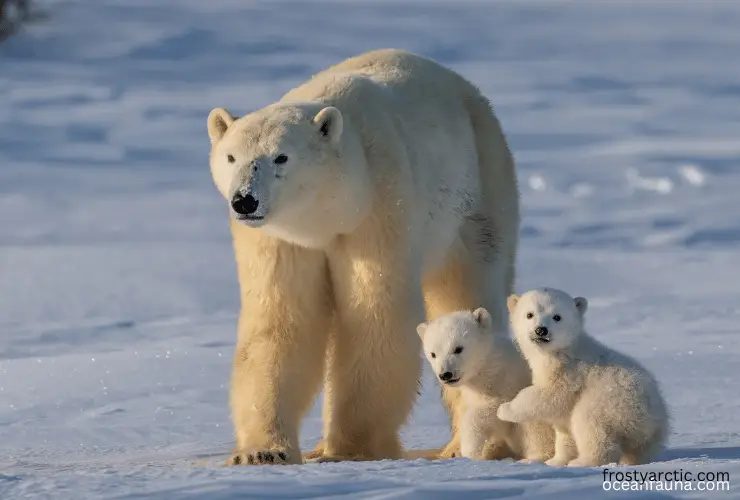
Baby polar bears are super cute and cuddly. Do you know how big they are? When a polar bear cub is born, it measures 30 cm (12 inches) from the tip of its nose to the end of its tail. For a few months, they stay with their mothers in the dens. Their size starts growing quickly when they reach the age of 2 months.
We are aware that you have a question on your mind: how much do polar bear cubs weigh? Cubs that have just been born typically weigh between 454 and 680 grams. They live with their mothers in the maternity wards for a few months. They start their journeys once they reach a weight of 10 kilograms and can walk.
The weight of polar bear cubs varies when they live in and leave their dens. Some of the cubs weigh as little as 3kg (6.6 lbs), while others reach weights of 24.5kg (54 lbs). As the number of offspring in a female polar bear’s litter increases, the individual size of each cub decreases. The heaviest cubs are single ones, followed by twins, and then triplets. One smaller cub mostly does not survive due to its lightweight body.
Why Are Polar Bears So Big?
Polar bears are so big for various reasons. For example, heat conservation is the reason behind the weighted polar bears in the cold Arctic regions. They are the largest carnivores on Earth and the biggest bear species.
Here are a few reasons that are contributing to the polar bear’s size:
1. Carnivorous Diet
As you know, polar bears primarily feed on high-calorie marine mammals like seals. Their large size helps them take down and consume these large prey. This diet provides them with more than enough energy to survive in cold weather. That’s why they become bigger and stronger than other mammals in the Arctic.
2. Predatory Advantage
Polar bears benefit from their large size when hunting. They can hunt prey more effectively. This ensures a stable food source to sustain their massive bodies. Thus, larger prey and their high-calorie diet make them one of the biggest bears. In return, big bodies help them catch bigger prey.
3. Insulation
The Arctic environment is extremely cold. So, polar bears need to conserve body heat. Their large size helps them maintain a lower surface area-to-volume ratio. It reduces heat loss to the surrounding environment.
4. Fat Reserves
We have discussed before that polar bears build up substantial fat reserves to survive periods of food scarcity in the summer. Their large bodies are capable of storing more and more fat. In this way, they have enough energy reserves to endure the lean months.
5. Maternal Care
Female polar bears need to survive for their cubs during their early, vulnerable stages. Larger body size is essential for them to survive. They can more easily nurse, safeguard, and transport their offspring with their large sizes.
6. Territorial Behavior
The Arctic is a vast and sparsely populated region. Larger polar bears may have a competitive advantage when it comes to defending their territories. Asserting dominance over smaller rivals is a small deal for polar bears. And you know what? The credit goes to their big bodies.
7. Genetic Factors
Over generations, larger polar bears may have been favored by natural selection. This is due to their increased chances of survival and reproductive success. So, it leads to the prevalence of larger individuals in the population. They also live longer due to their size.
8. Lack of predators
In the Arctic, polar bears are apex predators. It means they have no or fewer natural predators to keep their population in check. Without significant pressure from predators, they can evolve to be larger over time.
Polar Bear Weight Vs. Other Bears Weight
Here is a quick weight comparison table between polar bears and other bear species. Have a look at it:
| Polar Bears Weight Comparison with Other Bear Species | ||
| Bear Species | Average Weight | Average Length |
| Polar Bears | 350-680 kg (775-1500lbs) | 2.4-3 meters (8-10 feet) |
| Grizzly Bear / Brown bear | 150-350 kg (331-772 lbs) | 1.4 to 2.8 meters (4.7 to 9.2 feet) |
| Black Bears | 59 – 300 kg (130-661 lbs) | 1.27 to 2.03 meters (4.17 to 6.56 feet) |
| Giant Pandas | 70 to 250 kg (155-550 lbs) | 1.2 to 1.8 meters (4 to 6 feet) |
| Sun Bears | 27 to 65 kg (59-143 lbs) | 1 to 1.2 meters (3.3 to 4 feet) |
| North American Black bear | 219 to 453 kg (484-1000 lbs) | 1.3-2 meters (4.3 to 6.6 feet) |
| Sloth Bears | 90 to 140 kg (198-308 lbs) | 1.5-2 meters (5 to 6 feet) |
| Spectacled Bears | 100 to 200 kg (220 to 440 lbs) | 1.8-1.9 meters (6-6.5 feet) |
Polar Bear Weight Vs. Human Weight
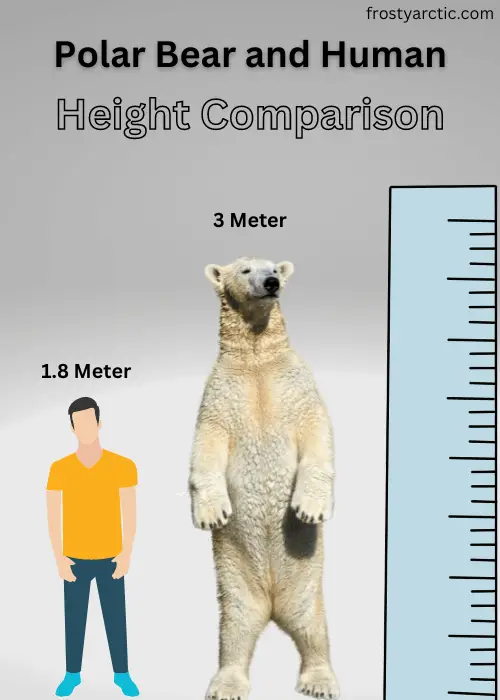
We already know that the height of a polar bear on its hind legs exceeds the height of a human by approximately 1.5 times. But, the height of polar bears on all fours is often the same as the average height of an adult human. The weight of a polar bear is always more than the weight of a human. Their weight surpasses the weight of a male human by over 5 times. Surprising? Yup!
Once again, we are comparing polar bears’ length and weight to humans. The typical adult male polar bear measures 2.4 to 3 meters in length (equivalent to 8 to 10 feet). And, they weigh around 350 to 680 kilograms (or 775 to 1500 pounds). On the other hand, an adult male human from the USA is about 1.75 meters tall (or 5 feet 9 inches). And, they weigh approximately 90 kilograms (or 198 pounds).
In comparison, polar bears are much larger and heavier than human males. Thus, we can say openly that humans are comparatively diminutive when placed beside the formidable polar bear. Polar bears are longer than humans, but the weight difference between the two is incredibly noticeable.
Polar Bear Weight Vs. Kodiak Bear Weight
Kodiak bears weigh about 357 kg. The coastal regions of Alaska and Kodiak Island are home to this subspecies of brown bear. Due to their weight, some of the Kodiak bears appear to be rivals of polar bears in terms of size.
However, they are rivals of just small-sized adult polar bears. The bigger polar bears are still bigger than the bigger Kodiak bears. According to the Guinness Book of World Records, Kodiak bears are also smaller in size than polar bears. But still, Kodiak bears are built robustly as compared to polar bears.
How Do Polar Bears Maintain Their Weight?

Polar bears maintain their weight by combining the following factors.
High-Calorie Diet (Blubber and Skin of Seals)
According to scientific facts, we all know that meat-eaters gain more weight than those who eat fiber. Primarily, polar bears eat seals.
The blubber and skin of seals are rich in calories. This type of high-calorie diet helps them maintain their body weight effectively. The weight of female polar bears can fluctuate greatly. Throughout their lifetime, their weight goes up and down.
Living in Dens
A mature female polar bear weighs between 330 and 550 pounds. A female polar bear’s size doubles during pregnancy. Pregnant polar bears weigh more than 1,100 pounds.
After giving birth to cute cubs, their weight also becomes half of 1,100 pounds. They stay in dens and hibernate. This is how they maintain their weight.
Efficient Metabolism
Polar Bears have a slow metabolism rate compared to other animals of similar size. This allows them to conserve energy when food is scarce. When they have access to food, their bodies are efficient at converting the high-fat diet into stored energy. Then, the polar bears can use it during periods of fasting or when food sources are scarce.
This is how they maintain their heavy body weight. Also, polar bears are highly skilled at conserving energy during their movements. They often walk at a slow pace and conserve energy by not exerting themselves unnecessarily.
Last but not least, the summertime food shortage for polar bears is longer. They use their stores of fat to maintain body weight and survive!
How Big Is the Biggest/Largest Polar Bear Ever Recorded?
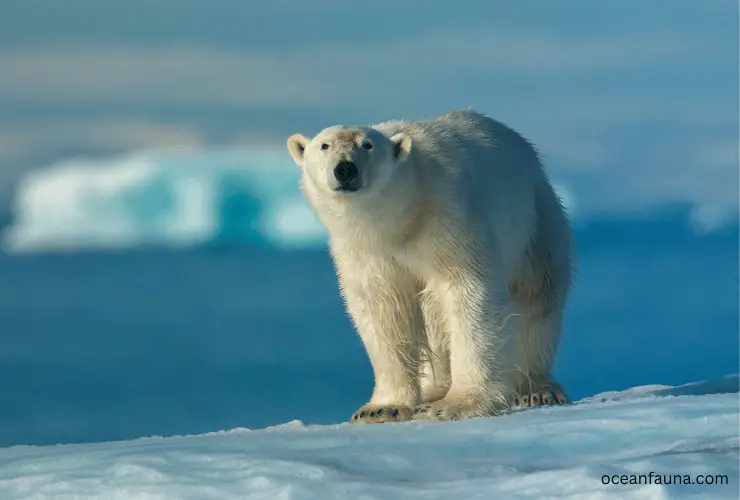
The largest polar bear ever recorded was a male bear known as the “largest polar bear ever killed” by hunters. This record-breaking polar bear was harvested in 1960 on the shores of Kotzebue Sound in Alaska. Its enormous size was officially measured and recorded by the Boone and Crockett Club. This is an organization that maintains records of North American big game animals.
According to the recorded measurements, this exceptional polar bear stood 11 feet 1 inch (3.39 meters) tall on its hind legs. Its skull was 29 3/16 inches (74.1 centimeters) long. This skull size is significantly larger than an average-sized polar bear skull. The length of this polar bear from the nose to the tip of the tail is still unknown.
This is also the largest polar bear ever recorded in terms of weight. It weighed approximately 2,210 pounds (1,002 kilograms). This immense weight is significantly higher than the average weight of adult male polar bears. This is because the weight of an adult male polar bear typically ranges from 775 to 1,500 pounds (350 to 680 kilograms).
FAQs’
Is the polar bear the biggest animal?
No, polar bears are not the biggest animals. There is a big list of animals and mammals (marineland+semi-aquatic+land) in the animal Kingdom that are bigger than polar bears. However, according to the report of the Library of Congress, polar bears are the largest species of bear on this planet.
And their close cousin, brown bears (especially Kodiak bears), are the second largest species of bear. These stats show it doesn’t mean polar bears are the largest animals. It simply means polar bears are the largest bear species. ~ Source
What animals are bigger than polar bears in comparison with their weight?
Whales (blue whales, beluga whales, killer whales, sperm whales), Saltwater Crocodile (Crocodylus porosus), Hippopotamus (Hippopotamus amphibius), Southern Elephant Seal (Mirounga leonina), and African Elephant (Loxodonta africana) are bigger than polar bears in comparison with their weight and size. There are also many other examples of animals in the animal Kingdom that are bigger than polar bears.
Are polar bears bigger than tigers?
Yes, polar bears are bigger than tigers. Let’s consider that the weight of a tiger ranges from 400 to 600 pounds. Now compare it with the weight of adult polar bears. The result shows the tiger’s weight is ⅓ times that of a polar bear. So polar bears are heavier. These bears have a stockier build compared to tigers.
Are polar bears bigger than lions?
Yes, polar bears are generally bigger than lions. Adult male lions typically weigh between 330 to 550 pounds (150 and 250 kilograms). On the other hand, adult polar bears weigh more than 1500 pounds. Polar bears are three times larger than lions. Do you know who will win the fight if they interact with each other?
Are polar bears bigger than elephants?
No, polar bears are not bigger than elephants. Elephants are the heaviest animals on Earth. A 14,000-pound animal has no match in size with any other animal.
Conclusion
Let’s wrap up the topic by paying tribute to the polar bears’ layer of blubber. Their extra fat, lengthy structures, and tallest heights have made everyone double-think about them. They weigh anywhere between 900 and 1,500 pounds and stand around 7 to 10 feet tall. That’s quite a sight to behold!
So, sincere thanks for your interest in these majestic mammals. We hope you enjoy reading about them as much as we enjoy sharing this information with you. Stay curious and keep exploring the wonders of the wild world!

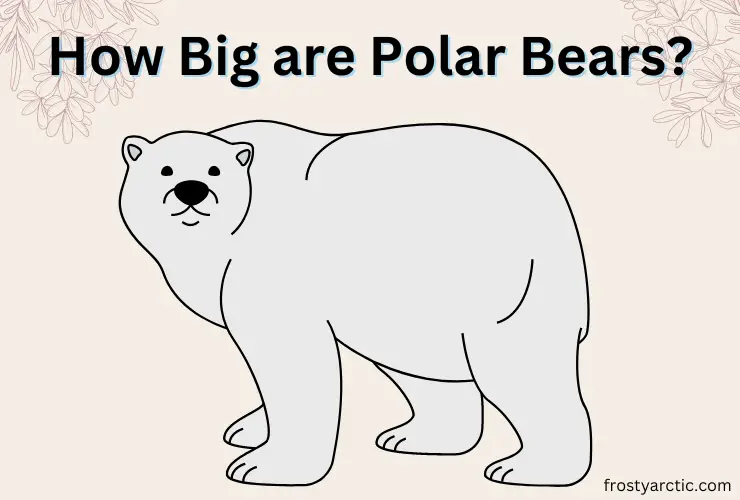

6 thoughts on “How Big are Polar Bears? [Height & Weight Explained]”